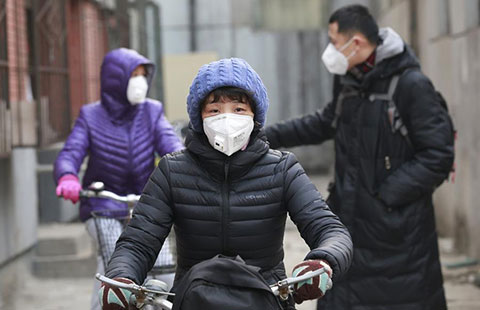Smog prompts more Chinese northern regions to issue 'red alert'
Updated: 2015-12-22 22:23
(Xinhua)
|
||||||||
BEIJING - China's northern Hebei Province and the port city of Tianjin issued their first-ever air pollution red alerts, the most serious level, joining neighboring Beijing in experiencing this most recent bout of choking smog.
China has a four-tier warning system, with red as its most severe level, followed by orange, yellow and blue.
Hebei, which is home to six of the ten most polluted Chinese cities in November, issued its first red alert for smog Tuesday noon.
Guo Yingchun, spokesperson of the provincial meteorological department, said all the province's 11 cities will roll out strict measures including limitations on the number of vehicles on the roads.
Actually, four cities in the province, including Baoding, Handan, Langfang and Xingtai, had issued red alerts before the provincial-wide alert.
On Monday night, Tianjin also issued its first red alert for air pollution, which will last from 0:00 a.m. Wednesday to 6:00 a.m.Thursday, according to a government statement.
During the red alert, cars will be allowed on the roads depending on whether their license plate ends in an odd or even number, enterprises and public institutions will adopt flexible working hours and large outdoor activities and construction work will be suspended.
Kindergartens, middle schools and primary schools will also cancel classes on Wednesday. Key polluting industries will cut production as continuous cleaning operations are conducted in the city's downtown areas.
Beijing was hit with severe air pollution on Tuesday, with pollution levels expecting to reach grade six on a six-grade pollution gauging system in the southern part of the city later in the day, according to Beijing Municipal Environmental Monitoring Center (BMEMC).
"Affected by increased humidity and temperature inversion, the density of PM2.5 (particles smaller than 2.5 micrometers used to measure air quality) may exceed 500 micrograms per cubic meter on Tuesday," according to Li Yunting, an environmental expert from BMEMC.
PM2.5 stood at 330 micrograms per cubic meter in Beijing as of 7:00 p.m Tuesday, data from BMEMC showed.
The capital will lift its second red alert at midnight on Tuesday. It began 7 a.m. Saturday.
The pollution level is predicted to decrease to grade four, still hazardous for health, on Wednesday, and the smog is expected to disperse on Thursday as a cold front arrives, said BMEMC.
Heavy smog has hit the country's Beijing-Tianjin-Hebei region on three occasions since late November. Low wind speed, high humidity and unfavorable wind conditions are the main causes of the smog, according to Li.
Meanwhile, other parts of north China also witnessed some of the worst smog so far this year from Saturday.
Orange, yellow and blue alerts have been issued in cities in the provinces of Henan, Shandong and Liaoning.
Limited visibility due to heavy fog and smog, the high-speed rail linking Shenyang, capital city of Liaoning, and the coastal city of Dalian cut its speed to 200 kilometers per hour from the usual 300 kilometers per hour, according to Shenyang railway bureau. The PM2.5 level was 248 micrograms per cubic meter in Shenyang as of 7:00 p.m Tuesday.
In addition, 15 highways in Liaoning Province were either completely or partially closed, according to the local transportation department.

 Whatever the shape or size of a tree, Merry Christmas!
Whatever the shape or size of a tree, Merry Christmas!
 The world in photos: Dec 14 - 20
The world in photos: Dec 14 - 20
 First American woman who works as captain for a Chinese airline
First American woman who works as captain for a Chinese airline
 Life of a family amid Beijing's red alert smog
Life of a family amid Beijing's red alert smog
 External coffin lid of 2,000-year-old Chinese tomb opened
External coffin lid of 2,000-year-old Chinese tomb opened
 First Miss Iraq named in decades
First Miss Iraq named in decades
 Iraq holds its first beauty contest in 40 years
Iraq holds its first beauty contest in 40 years
 Highlights at the Light of the Internet Expo
Highlights at the Light of the Internet Expo
Most Viewed
Editor's Picks

|

|

|

|

|

|
Today's Top News
Shooting rampage at US social services agency leaves 14 dead
Chinese bargain hunters are changing the retail game
Chinese president arrives in Turkey for G20 summit
Islamic State claims responsibility for Paris attacks
Obama, Netanyahu at White House seek to mend US-Israel ties
China, not Canada, is top US trade partner
Tu first Chinese to win Nobel Prize in Medicine
Huntsman says Sino-US relationship needs common goals
US Weekly

|

|








